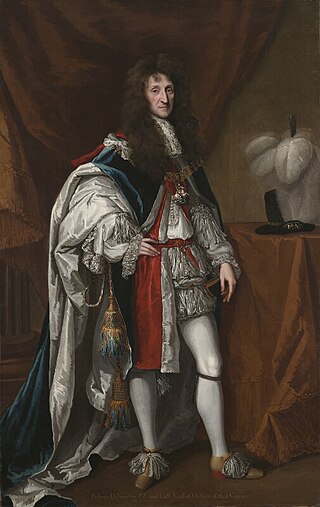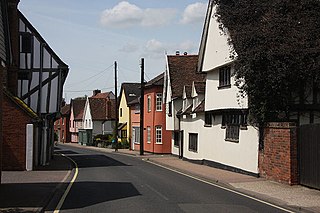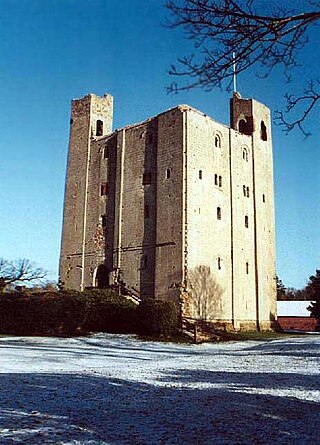





The House of de Vere was an old and powerful English aristocratic family who derived their name from Ver (department Manche, canton Gavray), in Lower Normandy, France. [2]






The House of de Vere was an old and powerful English aristocratic family who derived their name from Ver (department Manche, canton Gavray), in Lower Normandy, France. [2]
The family's Norman founder in England, Aubrey (Albericus) de Vere, appears in Domesday Book (1086) as the holder of a large fief in Essex, Suffolk, Cambridgeshire, and Huntingdonshire. His son and heir Aubrey II became Lord Great Chamberlain of England, an hereditary office, in 1133. His grandson Aubrey III became Earl of Oxford in the reign of King Stephen, but while his earldom had been granted by the Empress Matilda and eventually recognised by Stephen, it was not until January 1156 that it was formally recognised by Henry II and he began to receive the third penny of justice (one-third of the revenue of the shire court) from Oxfordshire. [3] [4]
For many centuries the family was headed by the Earl of Oxford until the death of the 20th Earl in 1703.
When John de Vere, 16th Earl of Oxford died suddenly in 1562, the de Vere estates were encumbered with debts and the young heir entered into the feudal wardship system of the young Queen Elizabeth I, [5] placed under "protection and authority" of the Court of Wards and Liveries and was sent to live in the household of her principal advisor, Sir William Cecil.
Among the offices the family held besides that of Lord Great Chamberlain was the forestership of Essex, and they founded the Essex religious houses of Colne Priory, Hatfield Broad Oak Priory, and Castle Hedingham Priory. [6] Macaulay described the family as "the longest and most illustrious line of nobles that England has seen", [7] and Tennyson's poem "Lady Clara Vere de Vere" made the name synonymous with ancient blood. [8]
Twenty males headed the family as Earl of Oxford from 1141 to 1703:
This summary genealogical tree shows how the house of de Vere is related:
| Aubrey de Vere 1st Earl (d. 1194) | |||||||||||||||||||||||||||||
| Aubrey de Vere 2nd Earl (d. 1214) | Robert de Vere 3rd Earl (d. 1221) | ||||||||||||||||||||||||||||
| Hugh de Vere 4th Earl (d. 1263) | |||||||||||||||||||||||||||||
| Robert de Vere 5th Earl (d. 1296) | |||||||||||||||||||||||||||||
| Robert de Vere 6th Earl (1257–1331) | Alfonso de Vere (d. 1328) | ||||||||||||||||||||||||||||
| John de Vere 7th Earl (1312–1360) | |||||||||||||||||||||||||||||
| Thomas de Vere 8th Earl (d. 1371) | Aubrey de Vere 10th Earl (1338–1400) | ||||||||||||||||||||||||||||
| Robert de Vere 9th Earl (1362–1392) | Richard de Vere 11th Earl (1385–1417) | ||||||||||||||||||||||||||||
| John de Vere 12th Earl (1408–1462) | Robert de Vere | ||||||||||||||||||||||||||||
| John de Vere 13th Earl (1442–1513) | George de Vere | John de Vere | |||||||||||||||||||||||||||
| John de Vere 14th Earl (1499–1526) | John de Vere 15th Earl (d. 1540) | ||||||||||||||||||||||||||||
| John de Vere 16th Earl (1516–1562) | Aubrey de Vere (b. 1519) | ||||||||||||||||||||||||||||
| Edward de Vere 17th Earl (1550–1604) | Hugh de Vere | ||||||||||||||||||||||||||||
| Henry de Vere 18th Earl (1593–1625) | Robert de Vere 19th Earl (1575–1632) | ||||||||||||||||||||||||||||
| Aubrey de Vere 20th Earl (1627–1703) | |||||||||||||||||||||||||||||
Arms of notable members of the de Vere family:


Earl of Oxford is a dormant title in the Peerage of England, first created for Aubrey de Vere by the Empress Matilda in 1141. His family was to hold the title for more than five and a half centuries, until the death of the 20th Earl in 1703. The de Veres were also hereditary holders of the office of Master Chamberlain of England from 1133 until the death of the 18th Earl in 1625. Their primary seat was Hedingham Castle in Essex, but they held lands in southern England and the Midlands, particularly in eastern England. The actual earldom was called "Oxenford" until at least the end of the 17th century. Medieval sources thus refer to "my lord of Oxenford" when speaking of the earl.
John de Vere, 13th Earl of Oxford, the second son of John de Vere, 12th Earl of Oxford, and Elizabeth Howard, a first cousin of John Howard, 1st Duke of Norfolk, was one of the principal Lancastrian commanders during the English Wars of the Roses.

Duke of St Albans is a title in the Peerage of England. It was created in 1684 for Charles Beauclerk, 1st Earl of Burford, then 14 years old. King Charles II had accepted that Burford was his illegitimate son by Nell Gwyn, an actress, and awarded him the Dukedom just as he had conferred those of Monmouth, Southampton, Grafton, Northumberland and Richmond and Lennox on his other illegitimate sons who married.

Castle Hedingham is a village in northern Essex, England, located four miles west of Halstead and 3 miles southeast of Great Yeldham in the Colne Valley on the ancient road from Colchester, Essex, to Cambridge.
Aubrey de Vere — also known as "Alberic[us] de Ver" and "Albericus regis camerarius" — was the second of that name in England after the Norman Conquest, being the eldest surviving son of Aubrey de Vere and his wife Beatrice.

Aubrey de Vere, 20th Earl of Oxford, KG, PC was an English peer and military officer who fought on the Royalist side during the English Civil War.

Lord Sidney Beauclerk was a British politician who sat in the House of Commons from 1733 to 1744. He acquired a reputation as a fortune hunter.

Isabel de Bolebec, Countess of Oxford, was the eldest daughter and co-heiress of Hugh de Bolebec II, Lord of Whitchurch, Buckinghamshire, and his wife, Margaret de Montfichet. She married Robert de Vere, 3rd Earl of Oxford, and was a benefactress of the Order of Friars Preacher (Dominicans) in England.

Bures is a village in eastern England that straddles the Essex/Suffolk border, made up of two civil parishes: Bures Hamlet in Essex and Bures St. Mary in Suffolk.

Aubrey de Vere, 1st Earl of Oxford was an English noble involved in the succession conflict between King Stephen and Empress Matilda in the mid-twelfth century.
John de Vere, 12th Earl of Oxford, was the son of Richard de Vere, 11th Earl of Oxford, and his second wife, Alice Sergeaux (1386–1452). A Lancastrian loyalist during the latter part of his life, he was convicted of high treason and executed on Tower Hill on 26 February 1462.

John de Vere, 15th Earl of Oxford, Lord Great Chamberlain KGPC was an English peer and courtier.
Agnes of Essex, Countess of Oxford was the daughter of a royal constable Henry of Essex and his first Cecily. At the age of three she was betrothed to Geoffrey de Vere, brother of the first Earl of Oxford, and turned over to be raised by the Veres soon thereafter. She remained in the household of the earl of Oxford about three years, then moved to Geoffrey's care. In her eleventh year Agnes rejected the match with Geoffrey and by early 1163 was married to his eldest brother Aubrey de Vere III, 1st Earl of Oxford, as his third wife.
Colne Priory at Earls Colne, Essex was a Benedictine priory, initially a dependent cell of Abingdon Abbey, Berkshire. It was founded by Aubrey de Vere I and his wife Beatrice in or before 1111. One piece of research suggests that the original Abbot, Faritius, was appointed in 1101; he initially placed six monks at the site. Their eldest son Geoffrey had died at Abingdon about seven or eight years earlier and was buried there. On his deathbed, Geoffrey had bequeathed to Abingdon the church and lands at Kensington, Middlesex, and his parents and brothers had confirmed that grant, as had King Henry I.

Robert de Vere, hereditary Master Chamberlain of England, was the son of Aubrey de Vere, 1st Earl of Oxford, and Agnes of Essex. He succeeded his brother as the third Earl of Oxford, and was one of the twenty-five guarantors of Magna Carta.

Hugh de Vere, 4th Earl of Oxford was the only son and heir of Robert de Vere, 3rd Earl of Oxford and Isabel de Bolebec, daughter and eventually sole heiress of Hugh de Bolebec.

Elizabeth de Vere, Countess of Oxford was an English noblewoman. As a young child she became a royal ward.
Aubrey (Albericus) de Vere was a tenant-in-chief in England of William the Conqueror in 1086, as well as a tenant of Geoffrey de Montbray, bishop of Coutances and of Count Alan, lord of Richmond. A much later source named his father as Alphonsus.
John de Vere, 14th Earl of Oxford was an English peer and landowner.
Sir John Spring, of Lavenham, Buxhall, Hitcham, and Cockfield, Suffolk, was an English merchant and politician.